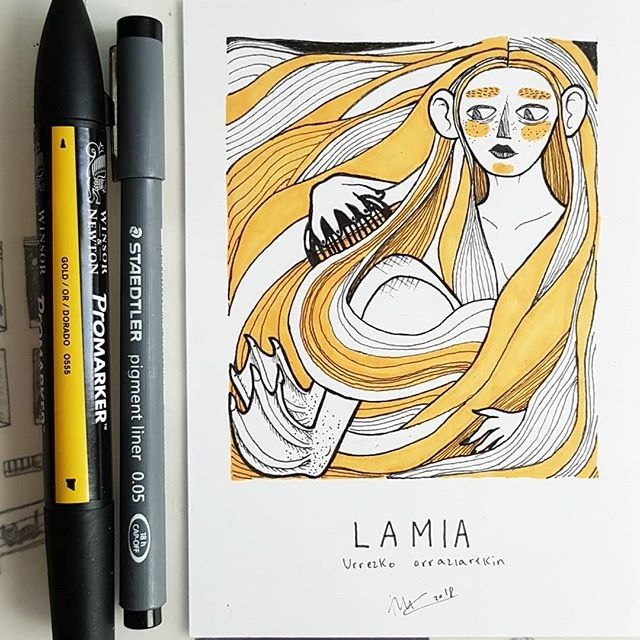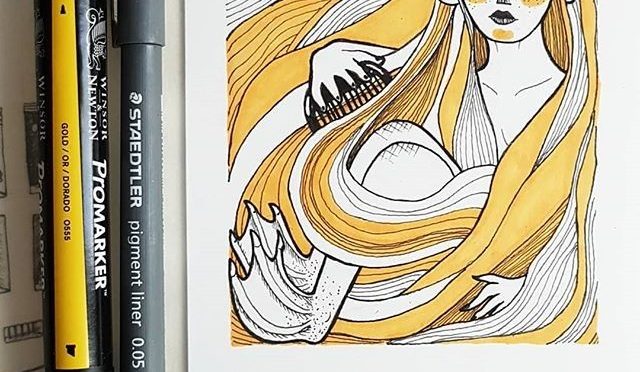Mythical creatures abound in Basque folklore, decorating the Basque countryside, from powerful god-like beings like Mari and Sugaar to more “common” creatures like Tartalo and Basajaun, creatures people might encounter as they go about their daily business. The lamiak are another such being. Living in the streams and ponds of Euskal Herria, their beauty – their feet not withstanding – often beguiles passing men.

- Lamiak – also called lamin, lamiña, amilamia, eilalamia, basandere, or saindimaindi depending on the location – have the appearance of a beautiful woman and spend much of their time sitting on a large rock next to a river, brushing their long, luxurious hair with a golden comb. However, their most striking feature is their feet. While typically depicted as having the feet of a duck, some describe them as having a hen’s or even a goat’s feet. And, in some stories, they have a tail like a fish.
- The golden comb is central to the myth of the lamia. It is their greatest treasure. If someone stole it, the lamia would find them, yelling at them from outside their window, and threatening to curse all of their descendants if the comb was not returned.
- Lamiak tend to live in caverns or in the backwaters of streams or springs. They are said to be builders, credited with constructing dolmens, bridges, churches, and castles. Like Mari, they live off of the “no,” the goods that people denied they had. They also fed themselves with the offerings from their devotees.
- While the origin of the word lamia comes from Latin, the Basque mythological figure has nothing to do with the sirens and mermaids of Roman lore. Rather, they are much more akin to nymphs than mermaids.
- Sometimes they are described as little people that live underground, or covered in long hair, with beards like monkeys. And in others they have no hair at all, except for a small patch on the back of their neck in the shape of a coin. Sometimes they appear lit up in their mouths.
- Lamiak require certain services, such as midwifery, from humans. If a human helped a lamiak, they were given ample gifts. However, they were not allowed to take anything without permission and, if they tried, were unable to leave the lamia’s dwelling. And they were forbidden to look back once they left. In one story, as a human reached home and crossed the threshold of their house, they looked back and immediately half of the gifts disappeared. Further, lamiak could not die without a human seeing them, even if they were in great agony. They needed the human to see them and recite a prayer before they could die.
- Lamiak have other interactions with humans as well. Sometimes, they fall in love. In one case, a lamia would only marry her suitor if he could guess her age, which a neighbor tricked her into revealing (105 years!). Sometimes they kidnap people, particularly those that don’t heed warnings to not return to their caves. And people sometimes kidnap the lamia, dredging ponds on the day of San Juan.
- There are many places in Euskal Herria named after the lamia. The oldest reference is back to 945, where “lamiturri” – or lamia’s fountain – is mentioned. Lamiategui – literally the place of the lamia – is mentioned as far back as 1221 and is a name that occurs in several places across the country. Lamindania is a mill in Lacarry that is said to have been built by the maide, the husbands of the lamiak. Lamiozingoerreka – stream of the lamias’ well – appears near Vera. There are many more such examples all over Euskal Herria.
- Today, there aren’t so many lamia, which is attributed to the church bells and the hermitages and shrines that, in some case, were said to be built specifically to drive the lamia away. Sometimes, more directly, their disappearance is traced to the spread of the Gospel.
Primary source: Hartsuaga Uranga, Juan Inazio. Lamia. Auñamendi Encyclopedia]. Available at: https://aunamendi.eusko-ikaskuntza.eus/en/lamia/ar-84676/
Discover more from Buber's Basque Page
Subscribe to get the latest posts sent to your email.



Thank you for all your informative posts. Learning so much about my Basque heritage
Ez horregatik! You are welcome. Thank you for the nice post!